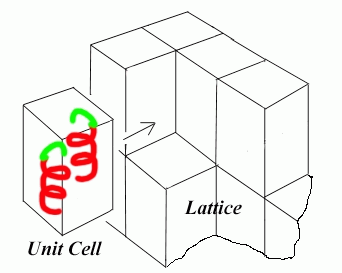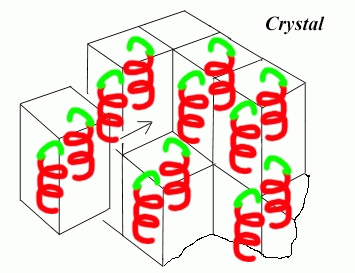In a previous chapter you have seen pictures of protein crystals and read about how to grow them. Although you can follow my tutorial up to the chapter on phasing techniques without knowing about the internal symmetry and space groups, you should have an idea of the concepts. Serious work like Heavy Metal Patterson interpretation requires a thorough knowledge of those subjects. I will only elaborate what is necessary to follow the advanced chapters of this on-line tutorial. I will refer the advanced reader to textbooks throughout the course.
A crystal is a periodic arrangement of a motif in a lattice. The motif can be a single atom, a small molecule, a protein or any combination thereof. So here is our protein, RGFP (Red-Green Fluorescent Protein) serving as a structural motif :

If we just repeat this motif in three dimensions, we have realized the most simple way to form a crystal. Very often the motif, also referred to as to the 'asymmetric unit', is subjected to a number of symmetry operations yielding differently oriented copies. Let's just use a 2-fold axis for now :

If there are no additional symmetry operations, we have already created the contents of the unit cell. The crystal is build from the unit cells arranged into a three-dimensional lattice :

So here is our final crystal of RGFP. Once you have worked through the two next sections, you should be able to tell what it's space group is. (To look ahead at a real life example, click here)

The question arises, how many ways are there to build crystals by combination of symmetry operations and lattice translations ? Infinite ? A few 1000 ? Time to look at this in more detail. Click here to go to Introduction to space groups.
![]() Back to X-ray Tutorial Introduction
Back to X-ray Tutorial Introduction
LLNL Disclaimer
This World Wide Web site conceived and maintained by
Bernhard Rupp (br@llnl.gov)
Last revised April 06, 1999 11:05
UCRL-MI-125269